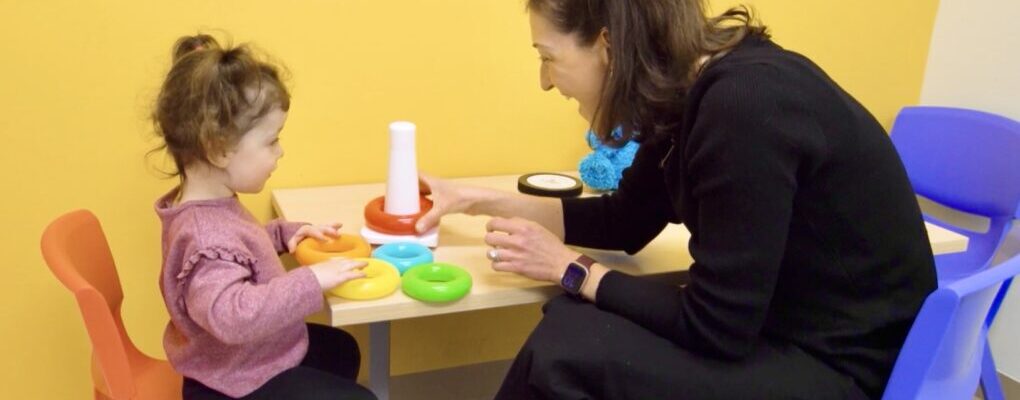Blog Categories
Search Blog
Blog Categories
Tips to Build Language in Everyday Situations
Does this ever happen to you? You come home from a long day of work, make dinner, eat, clean up, rush the kids for their bath and bedtime, and put them to sleep, only to realize that you barely actually had a conversation with your children. If so, you are NOT alone. Families often come into their weekly speech therapy sessions and report that they “didn’t have time” or “couldn’t squeeze in” their 10-15 minutes of “homework” each day.
With today’s busy schedules, setting aside time each day to work on your child’s communication skills is not always possible. Luckily, communication is part of everything we do, and it is easy to incorporate strategies to build your child’s language skills into many of our routine activities. Not only will your child benefit from the extra stimulation, but it will also turn these ordinary tasks into something fun for you and your child.
Here are some general goal areas that can be targeted during everyday routines:
Action Word Vocabulary: Building your child’s action word vocabulary can help him/her construct new and unique sentences
Concept Knowledge: Having a vocabulary of basic concepts helps to improve comprehension and encourages the use of more detail when describing things.
Sequencing: Being able to sequence the steps of routines is an important precursor to telling stories. Our stories are confusing if we can’t retell the events in the appropriate order.
Following Directions: Following directions is a critical language comprehension skill. As kids enter daycare and school, they are expected to be able to follow classroom instructions all day.
Many of our daily and weekly routines are great opportunities to work on language and communication skills.
Here are some examples:
Talking at the Grocery Store
One of the more mundane and frequently recurring tasks for caregivers is grocery shopping. The good news is that visiting the grocery store is a great way to work on language and communication. Here are a few ideas to get you started:
1. Action Words:
- Push/Pull: Model phrases talking about pushing or pulling the grocery cart.
- Open/Close: Model these words when you are opening and closing the doors to the freezer section or opening and closing produce bags.
- Bake: Visit the bakery section and model a “sentence” while talking about baking bread and other yummy treats.
2. Concept Knowledge:
- Early Concept Knowledge: Discuss the colour and shape of objects.
- Later Concept Knowledge: Build categorization skills by labelling items as either fruits, vegetables, meat, dairy, etc.
3. Following Directions:
- Give your child items to find. This is a good opportunity to practice listening and following directions, and it’s fun for your child. As your child gets better at following directions, you can give them multiple items to find at a time (multi-step directions) or use more complex language structures, such as “before you get the apples, get the carrots.”
- Try turning directions into a fun riddle game, which will support inferencing and problem-solving skills. For example, “We are looking for a vegetable that is orange and that rabbits love to eat”. Let your child have a turn giving you the “riddle”.
Talking During Bath Time
Bath time is a great opportunity to build your child’s language, no matter what their age or language level. Here are some practical tips that can be used during bath time:
1. Action Words:
- Wash: As stated above, to give your child many opportunities to practice this word, you can break down bath time and wash each body part one at a time. Model short phrases like “let’s wash your hair”. Emphasize “wash” as you wash each part.
- Squeeze: Have a variety of objects for your child to squeeze during bath time. Sponges and washcloths are great examples. Your child can also help squeeze the soap or shampoo bottles. Model the word “squeeze” as you do the action to make learning concrete.
- Pour: Fill up containers of different sizes and pour water into the bath. Have your child say “pour” as they do this. You can also fill a jug with water and pour water on different body parts, one at a time, to wash off the soap/shampoo.
2. Concept Knowledge:
- Full/Empty: Look at the bathtub before filling it with water. Discuss how it is empty. As the water fills the bath, comment on the fact that it is filling up. As your child gets into the bath, ask them to tell you if it is now empty or full. You can also work on full/empty as you fill different bath toys with water and dump them out.
- Wet/Dry: Have a variety of bath toys available for this activity. Once you are ready for “playtime” in the bath, pick up each toy, one by one, and have your child tell you if it is wet or dry. Ask them the same question after you have dropped the toy into the bath. By having lots of toys, it will give your child many opportunities to practice identifying wet/dry. As your child gets out of the bath, comment on how they are wet, but will soon be dry after using a towel.
- Clean/Dirty: Just like with the bath toys, we want many opportunities to practice these concepts. Instead of quickly washing your child, try washing one body part at a time. Have your child identify which body parts are clean (already washed) and which are still dirty (yet to be washed).
- Hot/Cold: Once your child is in the bath, run a washcloth under water of different temperatures and have your child touch the washcloth and identify if it is hot or cold. For older children, you can make this harder by using a larger variety of temperatures (e.g., cold, cool, warm, hot).
3. Sequencing:
- Talk about what you are doing as you are doing it. Use words such as first, next, then, and finally, as you describe what’s happening (e.g., first we fill the bath with water, next we get undressed, then we get into the bath, etc.).
- Once your child is able to retell the sequence in order, see if they can tell you the sequence of events BEFORE bath time.
- Once bath time is finished, have your child retell the steps in order. Cue them with reminders if they require help.
By following these simple suggestions, you will be able to turn your everyday routines into language learning time. Just remember – every routine is an opportunity to learn language!





